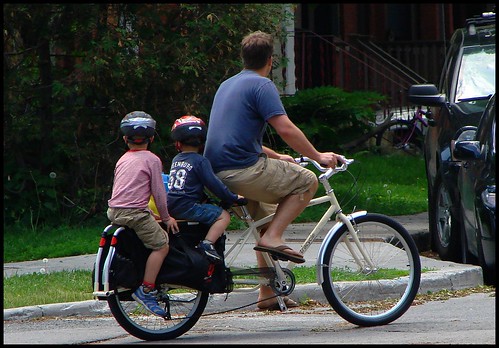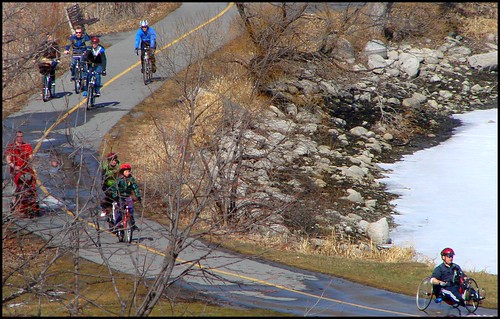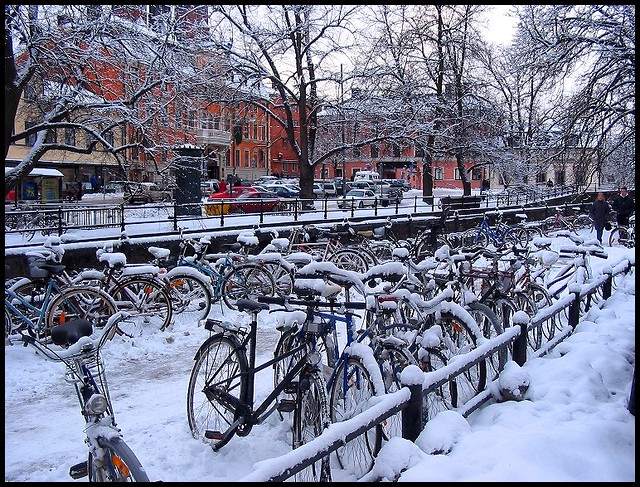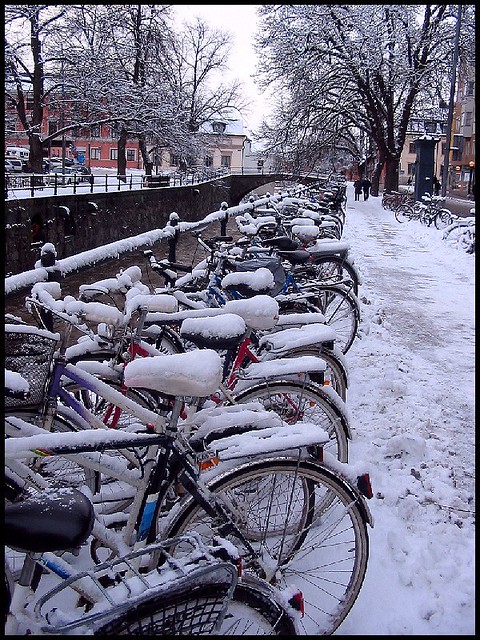Saturday (Nov 25) I attended the City of Ottawa’s Roads and Cycling Advisory Committee’s “Public Brainstorming Session”. Hosted by the RCAC’s Mike Powell, the session had the goal of coming up with some safety recommendations to be presented to the Ontario Coroner. (The Ontario Coroner had announced it would be looking at recent cycling deaths.)
The brainstorming session was well attended and Mike had us divided up at four tables with six or seven people to a table. At the tables were some familiar faces and quite a few Citizens for Safe Cycling members. The local media were well represented with CTV, CBC, Centretown News, Ottawa This Week and CBC Radio Canada all present. Councillor Marianne Wilkinson sat in, but I wasn’t sure in what capacity. Was she there simply to give her opinions like anyone else or was she acting on behalf of the city? I don’t know and I would’ve liked to have known at the start. Having said that, she did make some interesting comments and I was glad a city councillor took the time to participate.
Each table was given a question and we were asked to come up with concerns and potential solutions to problems. As you can imagine, there were many areas of concern and just as many ideas about what we could do about them. So, each table discussed a question and after twenty minutes of brainstorming we’d shuffle ourselves randomly at the other tables. There was a little overlap, but for the most part the tables changed membership.
I shall say here that the following ideas are not all mine, nor will I make any judgements on whether I find the ideas presented good or not.
Question 1. What are some of our safety concerns as cyclists?
It’s no surprise with the recent cycling death on Queen Street that
dooring was a major concern. Closely related was the use of
window tinting on cars. Many cyclists, and all safe cyclists, make a point of making eye contact with drivers. You're looking for signs of driver awareness and signals that a door is about to open.
Window tinting, of course, makes this difficult to impossible.
Window tinting is legal up to a point, but many felt that some after-market window tints are darker than legally allowed and that this creates a hazard to cyclists.
Proper maintenance of bike lanes is required to encourage winter cycling.
The right-of-way at
right hand turns was another safety concern.
Sharing the roads in close proximity to large construction vehicles and too fast traffic were noted often.
Narrow roads that put cars and bikes too close together were also noted. Somerset Street West is a good example of a street that's much too narrow. The south side allows for car parking, but if you ride along Somerset heading east you need to take the lane or else you will be much too close to the parked cars. This inevitably irritates impatient drivers. Debris and
poorly maintained bike lanes was mentioned. Cycle lanes that appear out of nowhere and end just as surprisingly are a major concern that was expressed at every table at some point. Last, but perhaps most importantly, was the
lack of respect that's shown to cyclists and admittedly the lack of respect that some cyclists show to car drivers. It was great to see that at no time did there ever appear to be an “us vs them” mentality in the room. Everyone seemed to recognize we have to work together in this.
Bike lane in Copenhagen
Question 2. What changes to infrastructure would we like to see?
Again,
dooring came up. It was suggested that more
angle parking may help in this regard. The
connectivity of our bike lanes was questioned and everyone agreed we need to fix this problem. Lanes that end at bridge approaches or that just fade away need to be fixed.
Traffic light signal timing was a possible change that most agreed with.
Advanced greens for cyclists and
turning boxes that give bikes a head start seem to be things most would like to see. Very important, and something that is very prevalent in many jurisdictions in Europe is the
slower speed limit along bike routes and in the more densely populated downtown area. As someone who was recently rear-ended by a speeding truck I’m strongly in favour of slowing vehicles down in the core of the city.
Safer zones around schools was another idea that I actually hadn’t heard of before. Some suggested as much as a three block radius around schools should be parking free zones to allow for safer commutes by children to school. Lastly, but probably only because so many seem to take it as the most important idea, is the use of
more segregated infrastructure. People generally feel safer away from heavy traffic and segregated bike lanes continue to be a strong favourite of most people. But not everybody!
Cyclists in Ottawa's Laurier segregated bike lane.
Question 3. What can we do about cycling awareness and education?
There were many interesting ideas including a
“think bike” campaign targeting bus, cab and large truck drivers.
Signage when entering areas with bike lanes was brought up. As well, the idea of the
"John School"* for drivers involved in accidents with cyclists and reckless cycists was a popular suggestion. Rather than being ticketed the charged motorist/cyclist could opt for some cycling education. Another well received idea was having city officials involved in road planning spend four hours on a bike in city traffic. This would likely change how they see things from a cyclist’s perspective. I would love to see that! It was also suggested that the Ministry of Transport put some information in their packages for
driver licence renewals reminding them to be aware of cyclists and the Highway Traffic Act as it applies to cars and bikes.
Question 4. What legal and regulatory changes could be implemented to make cycling safer?
Adopting a
mandatory minimum distance that cars must give cyclists (1 metre suggested) was easily the most noted change that people would like to see. Again, the issue of the tinted windows and why police seem to be ignoring some tints that are clearly illegal was talked about and it was suggested that the police themselves would have an interest in enforcing the laws that are already in place. However, some suggested that the maximum tint standard allowed today is too dark and should be changed. The
lack of side guards** on trucks were another concern. A recent accident in Toronto where side guards may have prevented a cyclist’s death has highlighted this again. With the rapid pace of development in downtown Ottawa now we are seeing a large number of trucks in the heavily congested core and this summer we had a pedestrian death involving a right-turning dump truck. Some work needs to be done to make trucks safer. Another change many wished to see is the
so-called Idaho Stop. This is where a stop sign can be treated as a yield sign for cyclists. It’s a very practical idea.
A bike "launch pad" on Laurier Avenue
These are just some of the topics that were discussed. There were far too many for me to put in this post (the infrastructure table had over 9 pages of notes!) but it does give you an overview of what we talked about. If I could pick five highlights for the session I would say that number one was the need for more separate/segregated infrastructure. This was the first item brought up at the infrastructure table. Number two would be the posted speed limit downtown. Most feel this needs to be lowered. Public awareness campaigns would be number three. Connecting the bike lanes we have to form a solid integrated network would be number four. It was unanimous that we have far too many dead links in this network. Number five concerned right-hand turns. Given this is where most accidents occur the participants had strong feelings about the need for advanced green lights and turning boxes (that put the bikes ahead of the cars) to keep cyclists safe when turning.
* What is “John School”?
http://en.wikipedia.org/wiki/John_school
**What are truck side guards?
http://www.theglobeandmail.com/news/national/infographic-truck-side-guards-designed-to-safeguard-cyclists/article2235084/?from=2235099




























